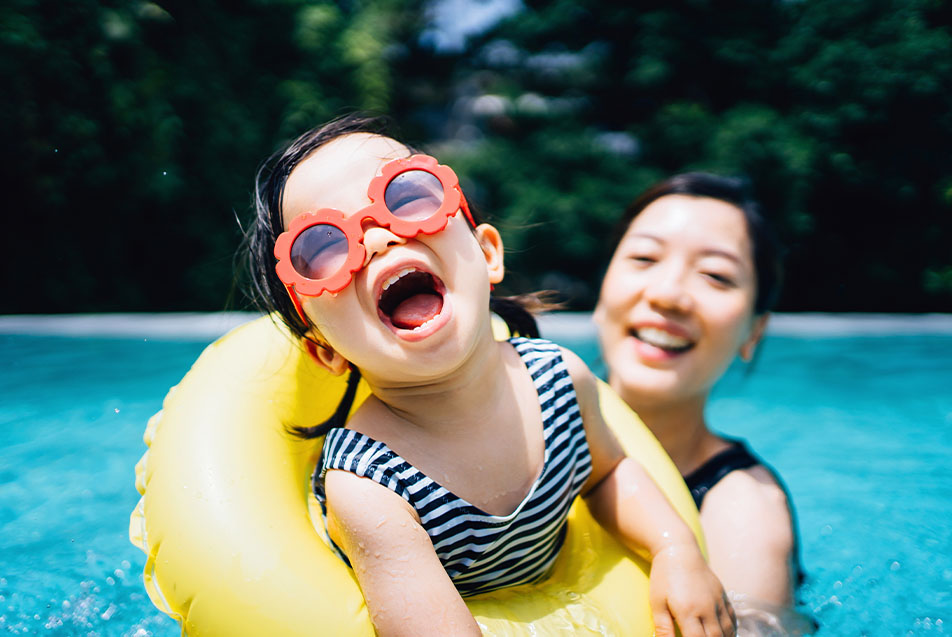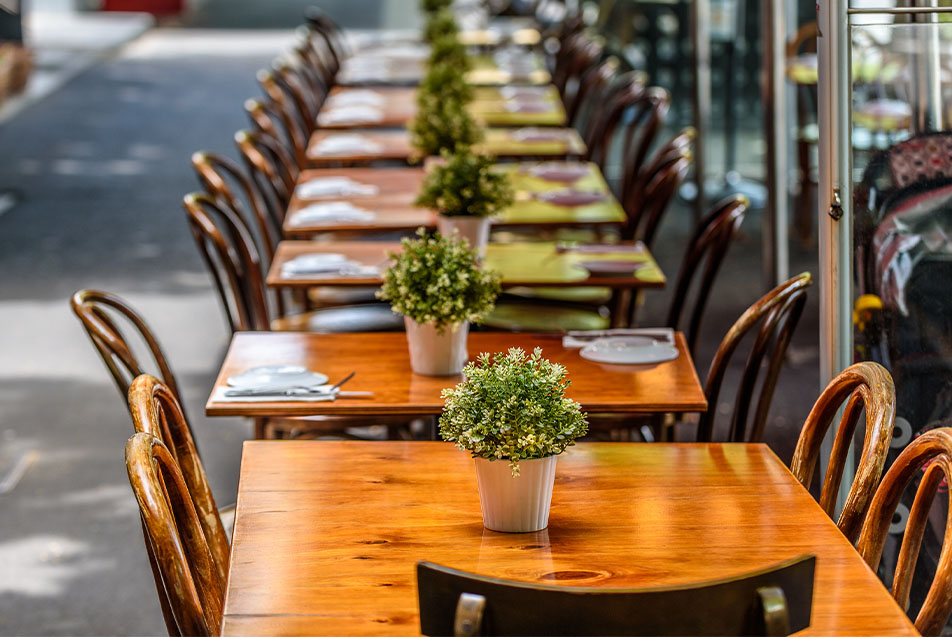
This post was written by Amy Simpson, DO, PPG - Family Medicine.
Summer is finally here! Having spent all spring pent up indoors, many of us are eager to get out and socialize. But we’re also wondering how to stay safe while still enjoying our favorite summertime activities. When planning your outings, you’ll want to think about the following:
- Personal space: Are you able to practice proper social distancing?
- Number of people: The fewer the better.
- Length of the activity: Shorter durations are better.
- Location: Being outdoors is safer than being indoors.
Now that you know what to look for, let’s take a look at some possible summer scenarios, what their risk levels might be, and how we can keep ourselves and our loved ones safe.
Flying: High risk
Airports are high traffic areas that serve people from all over the world. Once you’ve boarded the airplane, you’re in close proximity with many people, for an extended period, using a seat and tray table utilized by someone else and there’s only one small bathroom for dozens of people. With that said, many airlines have updated their policies surrounding disinfecting and cleaning the aircraft. So, if you must fly, it’s best to take all the appropriate precautions. Wipe down your area (the armrest, the seatbelt, the tray table, the window and window shade) as best you can. Wear a face covering, wash your hands frequently and avoid touching your face. Also, make sure your liquid hand sanitizer bottle is TSA compliant. Check out the airline’s website to review their specific guidelines.
Renting a car: Low risk
You and your family will be the only ones using the vehicle, so your overall risk is quite low. You can clean the steering wheel, dashboard and other surfaces before you load up. If you choose to do this, make sure you use a product that would be compatible with the type of fabric and materials inside the vehicle. The best way to make sure you don’t damage the vehicle is to ask about the rental company’s cleaning policies and procedures and see if they have any special recommendations.
Accommodations
Hotel: Low risk
At a hotel, you have the potential to come in contact with a lot of other people. If you limit the amount of time you spend in high traffic areas such as lobbies or common areas, the risk is considered relatively low. You can even make your room safer by cleaning high-touch items yourself like remotes, light switches and surfaces. You could ask about the hotel’s policy for cleaning these items, as well as bedding, bedspreads and curtains. Also, be sure to clean your hands after touching door handles, elevator buttons and hand railings in stairwells.
Resort: Medium to high risk
Staying at a resort is medium to high risk because you’re more likely to come in contact with others. There are a lot of communal spaces. So, if you are staying at a resort try to avoid high traffic areas and common spaces when possible. For meals, steer clear of buffet style, opting for carryout or room service instead. Select open-air dining rooms when you can. Choose outdoor music or dancing and avoid nightclubs packed with people in an indoor space. For excursions, choose something that limits the number of people per activity and allows you to socially distance.
Private rental location: Low risk
Staying at a private rental is low risk, but you will need to use caution regarding shared items. Kitchen utensils, eating and cooking surfaces, doorknobs, bedding, and linens all have contamination potential. Be sure to ask your host about their cleaning policies and procedures.
Pools, hot tubs, splash pads and water parks: Low risk
The biggest risk at pools, hot tubs, splash pads, and waterslides is other people. If you can successfully keep away from others while enjoying these activities, the risk is low. The water itself is not risky; the risk is being around large groups of people. Choose low traffic times of day, and if it becomes too crowded, consider returning on another day.
Going to a spa (massage, manicure, pedicures, facials): High risk
Massages, getting your nails done and other spa treatments have the potential to be high risk. You’re in very close proximity to at least one other individual and the activity can last over an hour. So, choose your location wisely and look for an establishment that’s taking extra steps to protect their clients and employees. Everyone should be wearing masks, regularly washing their hands and surfaces should be cleaned often.

Restaurants: Medium to high risk
Eating indoors at a restaurant could potentially be a high-risk activity. To reduce your risk, opt for outdoor seating and choose a restaurant that places tables six feet apart. Wait staff and employees should be wearing face masks. You should also wear your mask when getting up to use the restroom. Be sure to wash or sanitize your hands frequently, especially after touching any surfaces, chairs, menus, condiment bottles, or salt and pepper shakers. Many restaurants have taken steps to address this and have eliminated objects that stay on tables for multiple patrons to use. But, opting for takeout or a drive-thru instead of eating in a restaurant would further reduce your risk.
Theme parks: Medium to high risk
While theme parks offer a variety of outdoor activities, they tend to be crowded, making it difficult to keep your distance from others. Use caution with surfaces, seats, handlebars and waiting in line. And, because people tend to spend extended periods at amusement parks, check to see if they offer free re-entry so you can come and go based on the volume of people. You could also consider a multi-day pass so you can select low traffic times to visit the park. Many amusement parks also offer a way to skip the lines. Look to the theme park’s website for more information, as well as their hours, rules and regulations, and updated cleaning policies.
Parks and playgrounds: Medium to high risk
Parks and playgrounds offer “high touch” activities, so they’re an inherently higher risk. With that said, children as young as 3 years old can be taught to keep their hands, objects and toys out of their mouths while being instructed on frequent hand washing or the use of hand sanitizer. Not only will this help protect them from catching or spreading COVID-19, but it’s also encouraging them to continue healthy hygiene habits that will last a lifetime.
Camping and hiking: Low risk
Camping is a great way to get in touch with the serenity that nature can offer. If your style of camping involves selecting a quiet, private place to pitch a tent and enjoy a campfire with a few others, it’s a relatively low-risk activity. If you’re hiking, try to pick low traffic trails and give others space. Don’t share water bottles or other personal items. Sanitize your hands after passing around sunscreen and insect repellant. If you are at a campground or hiking trail that is packed with people, you may want to find a new location.
Stopping at gas stations: Low risk
You can’t get to your summer vacation destination without a stop or two to refuel. Stopping for gas is a low-risk activity. When possible, use a credit or debit card to pay at the pump and be sure to sanitize your hands after handling the gas nozzle. If you do go inside to pay, just keep it brief. Try to stay at least 6 feet away from others, wash your hands and wear your mask.
The bottom line
The only zero risk activity is staying isolated, indoors, by yourself. When deciding to participate in summer activities, everyone needs to consider their unique risks, especially those individuals with certain underlying health conditions, the elderly, the immunocompromised and anyone on certain medications that could be at a higher risk of poor outcomes. However, even if you are healthy, some of your loved ones may not be and you might not know it. Protect yourself and those around you by wearing a mask when possible, wash your hands frequently, practice proper social distancing when possible, opt for short duration outdoor activities and encourage those around you to do the same.
Also, keep in mind that other summer health and safety tips not addressed here are still extremely important. Please remember the basics of water safety, fire safety, sun protection, staying hydrated, wearing helmets and avoiding injuries.



